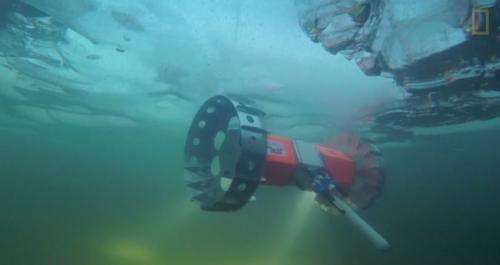June 25, 2014 weblog
Rover under-ice prototype may lead to Europa search

(Phys.org) —Scientists at NASA's Jet Propulsion Laboratory (JPL) have been working on a device that may one day explore the underside of ice on Europa, Jupiter's moon. NASA completed an early prototype of the rover it hopes will give us more information about Europa, with its abundant water and energy and chemistry. A National Geographic video shows the rover, called BRUIE (Buoyant Rover for Under-Ice Exploration) being taken for a run in Alaska. The team is interested in Europa, with its frozen, fissured surface and all. NASA's notes on Europa tell us it is an icy world slightly smaller than Earth's moon. A unique feature about Europa in the solar system is its global ocean of water in contact with a rocky seafloor. According to NASA, Europa could be a promising place to look for life beyond Earth. Europa's surface is mostly solid water ice, extremely smooth and crisscrossed by fractures.
A National Geographic video indicates the NASA effort is interesting not only because of Europa but because of the advances the Jet Propulsion Laboratory team made in developing its early prototype. This, after all, is a roving, untethered vehicle being shown under the Alaskan ice. When the probe reaches Europa, its search for life may be modeled on a trial such as this one. With explanations by astrobiologist Kevin Hand, the video shows testing around the frozen lakes of Barrow, Alaska. The scientists turned to Alaska's ecosystems where lakes freeze over every year, representative of life in an extreme environment, and helping to guide the NASA team in assessing if a world like Europa could harbor life.
They cut a hole in the ice, put the Rover underneath the ice and handed over control to engineers at the Jet Propulsion Laboratory."So we think this was the first time ever, that an underwater, under-ice, untethered vehicle has been operated through satellite link."
That last bit about an untethered vehicle operated through satellite link is a key part of their story. National Geographic described the moment when the engineers knew the satellite could work. "An electronic signal travels from NASA's Jet Propulsion Lab in Pasadena, California, to a robotic rover clinging to the underside of foot-thick ice on an Alaskan lake. The rover's spotlight begins to glow." The milestone involves a quest to develop an unmanned vehicle that may one day plumb the icy reaches of Europa.
NASA's Galileo mission explored the Jupiter system from 1995 to 2003, with flybys of Europa. It obtained the closest images to date of the moon's fractured surface. Attracting attention were strange pits and domes that suggested ice possibly slowly turning over, or convecting, due to heat from below. Last year, NASA announced evidence from researchers using the Hubble Space Telescope that Europa might be actively venting plumes of water into space.
More information:
solarsystem.nasa.gov/planets/p … Display=OverviewLong
www.nationalgeographic.com/astrobiology/
© 2014 Phys.org


















